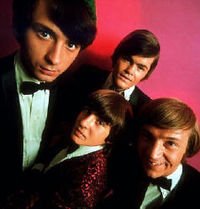
The Monkees in 1967 (left to right): Michael Nesmith, Davy Jones, Micky Dolenz, Peter Tork
The Monkees were a four-man musical band created to be the stars of an American television series of the same name, which ran on NBC
from 1966 to 1968. The Monkees were formed in 1965 in Los Angeles, California and disbanded in 1970. At their peak they were one of the most
popular musical acts of their time.
Several reunions of The Monkees have taken place. The first reunion lasted from 1986 to 1989 while another regrouping took place between
1996-1997. The Monkees last worked together in 2001.
History of the series
The television show first aired on September 12, 1966 on the NBC television network and lasted for two seasons (58 episodes); its final
primetime episode ran on September 9, 1968. Modeled on The Beatles' theatrical films A Hard Day's Night and Help!, The
Monkees featured the antics and music of a fictional pop-rock group which, due to the massive success of the records, and the public's
expectations, became a real pop group.
The four young men who became The Monkees were British-born David Thomas ("Davy") Jones (percussion/vocals/guitar), Hollywood native George
Michael ("Micky") Dolenz Jr. (drums/guitar/vocals), Texan Robert Michael ("Mike") Nesmith (guitar/vocals/keyboards), and Peter Halsten
("Peter Tork") Thorkelson (bass/keyboards/vocals), who had lived with his family in both the eastern United States and Canada.
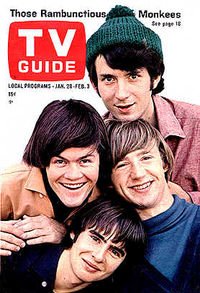
The success of the first season lands The Monkees on the cover of TV Guide, January 1967
They were cast after ads were placed in trade publications like Variety calling for "folk & roll musicians" to play "4 insane boys" on a
new television series. 437 hopeful actors and musicians auditioned for the parts; a then relatively unknown Stephen Stills was shortlisted
for a role, but lost out because producers Bob Rafelson and Bert Schneider felt he looked too old for the part, and because he did not want
to assign his music publishing rights to Screen Gems. Stills referred friend and former roommate Tork to audition.
Nesmith (releasing pre-Monkees singles as "Michael Blessing") and Tork (part of the folk music scene in Greenwich Village) were both already
professional musicians. Dolenz (who starred in the 1950s series Circus Boy) and Jones (who appeared with the cast of Oliver! on
The Ed Sullivan Show the night of The Beatles' debut on live American TV) were better known as actors but also had musical and recording
experience, with Jones performing in musical theatre in England and in Broadway theatre in New York, and releasing a solo album, and Dolenz
singing and playing guitar in Los Angeles area bar bands.
All four Monkees were trained in both improvisational comedy and stage presence as a group before the pilot episode was filmed, so that they
could look and act like a cohesive band even though it was only their voices being used on the initial recordings. Each was given a different
personality to portray: Dolenz the funny one, Nesmith the smart and serious one, Tork the naive one, and Jones the cute one. Their characters
were loosely based on their real selves, with the exception of Tork, who was actually a quiet intellectual. Choosing someone to play the
drummer proved tough; Nesmith and Tork did not want to give up their guitars, and the five foot, three inch Jones nearly vanished behind
the drums. Dolenz ultimately took the job, and began drum lessons. (According to Rhino Records liner notes, by the time of their first solo
tour, Dolenz had had only a crash-course in drums, and to this day, he still sets up his drum kit as if he were left-handed, as his drum
teacher had been, when he is actually right-handed.)
The series was filmed at Columbia Pictures, the studio that made The Three Stooges short films from 1934 to 1958. Many of the same sets from
the Three Stooges were used on the Monkees, and even some of the same props, most notably the pajamas with a bunny design on the front. This
was worn by Peter Tork in several episodes, as well as Curly Howard in several of their 1940s films.
As a television show, The Monkees used techniques rarely seen on television - characters breaking the fourth wall and talking to the
camera and sometimes even to people off-camera in the studio, fantasy sequences, jump cuts, and at least once a week a musical romp which
might have nothing to do with the story line. In fact, many of the episodes included what now look very much like music videos: short,
self-contained films of songs that were later collected and released as albums.
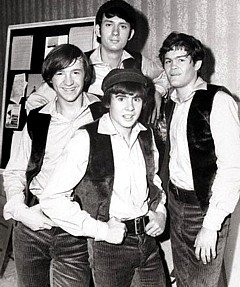
Early promotional photo of The Monkees on the set of the pilot, 1965
The 1965 pilot episode was co-written by Paul Mazursky and the late Larry Tucker, who later co-wrote the movie Bob & Carol & Ted
& Alice, which Mazursky directed; he went on to direct such films as Harry and Tonto and Down and Out in Beverly Hills.
Series producers Schneider and Rafelson also went on to make movies, commencing with 1969's Easy Rider (co-produced with star Dennis
Hopper). Rafelson went on to direct such films as Five Easy Pieces and The King of Marvin Gardens.
The Monkees won two Emmy Awards in 1967: Outstanding Comedy Series and Outstanding Directorial Achievement in Comedy (James Frawley).
The series was a forerunner to such similar gag-based comedies as Airplane!, Scrubs, and Moonlighting.
Beyond television
During the filming of the second season, the band tired of scripts and storylines they deemed monotonous and stale. Various band members
proposed switching the format of the series to become more like a variety show, with musical guests and live performances. This desire was
partially fulfilled within some second season episodes, with guest stars like musicians Frank Zappa, Tim Buckley and Charlie Smalls (composer
of The Wiz), performing on the show. However, NBC was not interested in changing the existing format, and the group expressed little
desire to continue for a third season.
After the television show was cancelled, Rafelson directed the four Monkees in a feature film, Head, originally titled "Untitled." The
film was executive-produced by Schneider and co-written and co-produced by Rafelson with a then relatively unknown actor named Jack Nicholson.
The film was given its title so that, if a sequel was made, said sequel could be advertised as "From the people that gave you Head".
Sparse advertising (with no mention of the Monkees whatsoever) squelched any chances of the film doing well, and it played briefly in empty
movie houses.
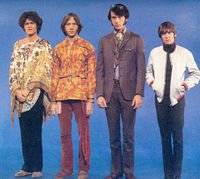
The Monkees in their failed 1968 TV special, 33 1/3 Revolutions Per Monkee (left to right): Micky Dolenz, Peter Tork, Mike
Nesmith & Davy Jones
Nicholson also assembled the film's soundtrack album. The film, created and edited in a stream of consciousness style, featured cameo appearances
by movie stars Victor Mature, Annette Funicello, a young Teri Garr, boxer Sonny Liston, famous stripper Carol Doda, and musician Frank Zappa. It
was filmed in Screen Gems Studios and on location in California, Utah, and The Bahamas between February 19 and May 17, 1968 and premiered in New
York City on November 6 of that year. (The film later debuted in Hollywood on November 20.) It was not a commercial success. This was in part
because Head, being an antithesis of The Monkees TV show, comprehensively demolished the group's carefully-groomed public image,
as evidenced by the stanzas from Rafelson and Nicholson's "Ditty Diego-War Chant" (recited at the start of the film by the Monkees), which
ruthlessly parodies Boyce and Hart's "Monkees Theme."
But over the intervening years Head has developed a cult following for its innovative style and anarchic humor, and the soundtrack album
(long out of print but now available in an expanded CD version) is counted among their best recordings. Members of the Monkees, Nesmith in
particular, cite Head as one of the crowning achievements of the band.
From TV to stage
Critics of The Monkees complained that they were simply a made-for-TV knockoff of The Beatles, but the Beatles didn't seem to mind. John Lennon
was a fan of the show, comparing its humor to The Marx Brothers. George Harrison praised their self-produced musical efforts, saying "When they
get it all sorted out, they might turn out to be the best." (Peter Tork was later one of the musicians on Harrison's Wonderwall Music,
playing Paul McCartney's five-string banjo.) Longtime Beatles confidant Peter Shotton commented in his book The Beatles, Lennon and Me,
"The Monkees are what the Beatles pretend to be."
The massive success of the series and its spin-off records had created intense pressure to mount a touring version of the group by late 1966.
Against the initial wishes of the producers, Dolenz, Jones, Nesmith and Tork went out on the road. The results were far better than anyone had
a right to expect, and wherever they went they were greeted by scenes of fan hysteria not seen since The Beatles. This gave the four stars
increased confidence in their battle for creative control over the music used in the series.
The Monkees had complained that the producers would not allow them to play their own instruments on their records. This campaign eventually
forced the series' musical coordinator Don Kirshner to let them have more participation in the recording process (against his strong objections),
which included Nesmith producing his own songs and band members making some instrumental contributions. Led by Nesmith, the band eventually
rebelled against Kirshner, who was later fired. Beginning with their third album, Headquarters (which was produced by Chip Douglas),
the four Monkees wrote and played on much of their own material. However, they continued to employ session musicians (reputable players like
Louie Shelton, members of The Byrds and The Association, and newcomers, like Neil Young) throughout their recording career.
Kirshner was reported to have been incensed by the group's rebellion and swore never to repeat his mistake. This experience led directly to
his later ventures The Archies and Josie and The Pussycats, which were animated series - the "stars" existed only on an animation cel and
obviously could not demand creative control over the records issued under their name.
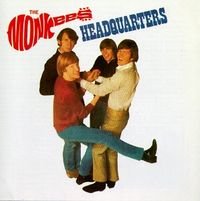
Headquarters album cover, 1967
When the group toured Britain in 1967, there was a major controversy over the revelation that the group did not play on their own records. The
story made the front pages of several UK and international music papers, with the group derisively dubbed "The Pre-Fab Four." Nevertheless, they
were warmly welcomed by many top British stars, who knew the group included some skilled musicians and sympathised with their wish to have more
control over their music.
Many Monkees fans now feel that the controversy unfairly targeted The Monkees and conveniently ignored the fact that a number of the leading
British and American groups (including critical favorites such as The Byrds and The Beach Boys) habitually used session players on their
recordings, and that this practice had always (until then) passed without comment. However, The Beatles had led a wave of groups who played
their own instruments and wrote their own songs, and The Monkees' output paled by comparison in the eyes of many. The Byrds song "So You Want
to Be a Rock and Roll Star" had been aimed squarely at the Monkees phenomenon, with writers Roger McGuinn and Chris Hillman reconsidering their
opinions later, after they had met the band.
Supporters and critics of the group agree that the producers and Kirshner had the good taste to use some of the best songwriters of the period,
including Neil Diamond, Tommy Boyce and Bobby Hart, Gerry Goffin and Carole King, Harry Nilsson, Cynthia Weil, as well as using top-ranking Los
Angeles session musicians on the records. The Monkees had several international hits - which are still heard on pop and oldies stations -
including "I'm a Believer," "(I'm Not Your) Steppin' Stone," "Daydream Believer," "Last Train to Clarksville" - and even a number of social
criticism songs, the best known of which is probably "Pleasant Valley Sunday." Screen Gems held the publishing rights to a wealth of great
material, with the Monkees given first crack at many new songs, and they never had to record a song they really disliked, as Dolenz affirmed
on The Larry King Show in 1987. (They would sometimes lampoon songs during takes, though, as with "Gonna Buy Me a Dog", with those takes
sometimes being the ones picked.)
The Monkees also deserve credit for helping bring America's attention to the Jimi Hendrix Experience, who they took on as an opening act during
their Summer 1967 concert tour, even though Hendrix quit after only a few shows. Reports circulated at the time that he had been removed from
the tour after complaints from the conservative women's group Daughters of the American Revolution. This was later proved false, and it has since
been revealed that the story was concocted for publicity purposes by the late Australian journalist and music writer Lillian Roxon, who had been
accompanying the tour with her friend, the Australian singer Lynne Randell, who was one of the supporting acts and who was romantically involved
with Jones at the time. Most likely, Hendrix and his group were frustrated at appearing before audiences largely populated by young women, who
had no interest or appreciation of their brand of musical innovation.
The End of The Monkees
Six albums were produced with the original lineup (four of which went to Number 1 on the Billboard chart), which was supplemented by a series
of successful world concert tours. But tensions within the group were increasing, and Tork quit shortly after the band's Far East tour in late
1968, but not before completing work on their 1969 NBC television special, 33 1/3 Revolutions Per Monkee. Three more albums would follow
while Tork (in December 1968) and then Nesmith (in March 1970) left the group, leaving only Dolenz and Jones to record as The Monkees. Eventually,
Jones too departed, leaving Dolenz as the sole remaining recording Monkee, and so marked the end of the first phase of The Monkees' recording career.
At the same time, The Monkees TV series enjoyed a resurgence on Saturday afternoon television for four seasons on CBS (September 1969-September
1972) and on ABC (September 1972 - August 1973), after which its 58 episodes were sold to local markets for syndication in September 1975. The
show appeared on independent television stations on weekday afternoons.
A new collection, The Monkees Greatest Hits, charted in 1976 due to a new generation of young fans viewing the show for the first
time during the syndicated repeats. Dolenz and Jones subsequently took advantage of this exposure. They joined ex-Monkees songwriters Tommy Boyce
and Bobby Hart to tour the United States. As the "Golden Hits of the Monkees" show ("The Guys who Wrote 'Em and the Guys who Sang 'Em!"), they
had success in smaller venues, including state fairs and amusement parks, and also overseas, making stops in Japan, Thailand and Singapore.
Adopting the name Dolenz, Jones, Boyce and Hart, they also released an album on Capitol Records (they could not use the Monkees name due
to legal reasons). A possible reunion of the full group at that time failed to materialize, with Nesmith not interested and Tork saying later he
had not been asked, although a Christmas single with Dolenz, Jones and Tork was released in 1976.
Revival
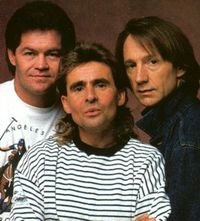
The partially reunited Monkees in 1987
Brushed off by critics during their heyday as manufactured and lacking talent, The Monkees experienced a critical and commercial rehabilitation
in 1986. A Monkees TV show marathon ("Pleasant Valley Sunday", airing on February 23) on the video music channel MTV re-launched the group,
sparking worldwide interest by both original fans and their children, who flocked to see Dolenz, Jones and Tork on their "20th Anniversary Tour."
The marathon effectively resurrected Monkeemania, and the tour was forced to move from smaller venues to larger stadiums.
Spurred on by massive MTV promotion, the reunited trio quickly became one of the hottest acts of 1986 and 1987, with their original albums
selling in the millions and a new greatest hits collection reaching platinum status. To show his support, Nesmith appeared onstage with Dolenz,
Jones and Tork twice, both times in Los Angeles, in 1986 and 1989. Nesmith was forced to sit out most of these reunion projects because of prior
commitments to his bustling Pacific Arts video production company. However, he did appear with the band in a 1986 Christmas medley music video
for MTV, and took part in a dedication ceremony at the Hollywood Walk of Fame, when The Monkees received a star there in 1989. (Independently
wealthy through his mother Bette Nesmith Graham, the inventor of Liquid Paper, Nesmith has little need to join in Monkees-related projects.)
The sudden revival of The Monkees in 1986 helped move the first official Monkees single since 1970, "That Was Then, This Is Now," into the
American Top 20. A new album by the touring trio, Pool It!, appeared the following year and met with moderate success. From
1986 to 1989, The Monkees would conduct major concert tours in the United States, Australia, Japan, the United Kingdom and Europe.
In 1986 Straybert Productions capitalized on the revival by creating a new television series called The New Monkees. Four young musicians
were placed in a similar series based on the original show, this time "updated" for the 1980s. The show and its accompanying album sank quickly
without a trace.
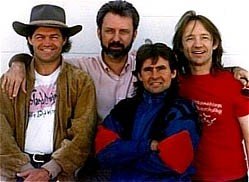
Michael Nesmith rejoins his bandmates in Los Angeles, 1989
In the 1990s, The Monkees continued to create new musical material, eventually recording an album which all four members performed and produced,
Justus, in 1996. The trio of Dolenz, Jones and Tork reunited again for a successful 30th anniversary tour of American amphitheaters
in 1996, while Nesmith joined them onstage in Los Angeles to promote the new songs from Justus. For the first time since the initial
reunion in 1986, Nesmith returned to the concert stage for a tour of the United Kingdom in 1997, and two sold-out concerts at Wembley Arena in
London highlighted the success of the band in the 1990s. The full quartet also appeared in an ABC television special (written and directed by
Nesmith) that year, spoofing the original series that had made them famous.
Unfortunately, once the initial interest had died down (and in the face of some negative reviews of his recent performances with the Monkees),
Nesmith was a no-show when the American leg of their 1997 concert tour began. Davy Jones went on record to say another reunion of The Monkees
as a complete unit "will never happen again." The remaining three members (Dolenz, Jones and Tork) tour sporadically, most recently in 2001.
Impact of The Monkees
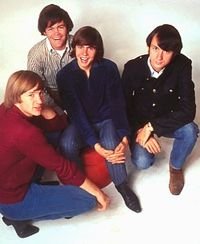
The Monkees in 1967
The Monkees, selected specifically to appeal to the youth market with their manufactured personae and carefully produced singles, are sometimes
popularly seen as the original precursor to the modern proliferation of studio and corporation-created bands. The Monkees however were not the
first manufactured group. The Monkees also frequently contributed their own songwriting efforts on their albums and while some group members
might have been inexpert musicians at first, their skills improved and they ultimately became a self-directed group, playing their own instruments
and writing their own songs.
The critical appeal of The Monkees has only increased in the decades since their original inception. The Monkees found unlikely fans among
musicians of the punk rock period of the mid-1970s. Many of these punk performers had grown up on TV reruns of the series, and in keeping
with the prevailing anti-industry, anti-Establishment trend of their music, they adopted The Monkees as symbols of rebellion against the
mainstream music industry, citing the group's insistence on breaking out of their manufactured TV image and proving that they could write
and perform as a real band. In 1988 Run DMC did a cover of "Mary, Mary" on their album Tougher Than Leather. The Monkees were and continue
to be a major influence on indie-rock and indie-pop bands in Australia and elsewhere with Australian indie-rock bands of the 80's such as
Grooveyard ("All The King's Horses") and The Upbeat and The Mexican Spitfires ("Mary Mary") covering songs written by Nesmith and Tork in
their live performances. Modern day bands continue to cover their work, with the alternative rock group Smash Mouth most recently having
a hit with "I'm a Believer" in 2001.
Millions of people still listen to their music. In fact, their legacy has been further strengthened by Rhino Entertainment's acquisition of
The Monkees' franchise from Columbia Pictures in the early 1990s, with remastered editions of both the original television series and their
music library having now surfaced in stores on DVD and compact disc collections.
List Of Notable Achevements
- Had the top-selling American single of 1967 ("I'm a Believer").
- First starring cast in a television series to have long hair.
- First rock band to extensively use the Moog Synthesizer on a pop album.
- First rock band to extensively use the pedal steel guitar on a pop album.
- Outsold the Beatles and Elvis Presley combined in 1967.
- First TV sitcom to make political and social comments defending the youth of America.
- First marriage between television and record industry.
- First use of polarization in a major motion picture.
- First television series to show teenagers living on their own.
- First rock band to use a multimedia live concert show.
- Gave the Jimi Hendrix Experience their first US concert appearances.
- First "manufactured" rock band (The Pre-Fab Four).
- First American band to play in Thailand.
Discography
Unless noted, all releases listed are American releases.
Studio albums (partial)
- The Monkees (1966) (#1)
- More of the Monkees (1967) (#1)
- Headquarters (1967) (#1)
- The Birds, The Bees, & The Monkees (1968) (#3)
- Head (1968) (#45)
- Instant Replay (1969) (#32)
- The Monkees Present (1969) (#100)
- Changes (1970) (#152 in 1986)
- Pool It! (1987) (#72)
- Justus (1996) (#200)
Live Albums & Compilations
- A Barrel Full of Monkees (1971)
- Re-Focus (1972)
- The Monkees Greatest Hits (1976)
- More Greatest Hits of the Monkees (1982)
- Monkee Business (1983, picture disc)
- Monkee Flips (1984)
- Hit Factory (1985)
- Then And Now...the Best of The Monkees (1986)
- Live 1967 (1987)
- 20th Anniversary Tour Live (1987)
- Missing Links (1987)
- Missing Links, Volume II (1990)
- Listen to the Band (25th Anniversary boxed set) (1991)
- Greatest Hits (1995)
- Missing Links, Volume III (1996)
- Anthology (1998)
- Music Box (35th Anniversary boxed set) (2001)
- The Best of The Monkees (2003)
- "The Monkees - Headquarters Sessions" (3-CD set) (for sale on internet only)
Singles
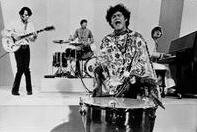
The Monkees in 1967
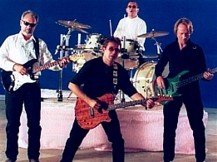
The Monkees in 1996
- "Last Train to Clarksville" (1966) (#1) /
- "I'm a Believer" (1966) (#1) /
- "(I'm Not Your) Steppin' Stone" (1966) (#20)
- "A Little Bit Me, A Little Bit You" (1967) /
- "She Hangs Out" (1967) (Canadian release; withdrawn from sale)
- "A Little Bit Me, A Little Bit You" (1967) (#2) /
- "The Girl I Knew Somewhere" (1967) (#39)
- "Randy Scouse Git" (Alternate Title) (1967) (#2) /
- "Forget That Girl" (1967) (UK release)
- "Pleasant Valley Sunday" (1967) (#3) /
- "Daydream Believer" (1967) (#1) /
- "Goin' Down" (1967) (#104)
- "Valleri" (1968) (#3) /
- "Tapioca Tundra" (1968) (#34)
- "D.W. Washburn" (1968) (#19) /
- "It's Nice To Be With You" (1968) (#51)
- "Porpoise Song" (Theme from 'Head') (1968) (#62) /
- "As We Go Along" (1968) (#106)
- "Teardrop City" (1969) (#56) /
- "A Man Without A Dream" (1969)
- "Listen to the Band" (1969) (#63) /
- "Someday Man" (1969) (#81)
- "Good Clean Fun" (1969) (#82) /
- "Mommy and Daddy" (1969) (#109)
- "Oh My My" (1970) (#98) /
- "I Love You Better" (1970)
- "Do It In The Name Of Love" (1971, credited to Dolenz and Jones) /
- "That Was Then, This Is Now" (1986) (#20) /
- "(Theme From) The Monkees" (1986)
- "Heart and Soul (1987)" (#87) /
- "Every Step of the Way" (1987) /
- "(I'll) Love You Forever" (live) (1987)
This article is licensed under the GNU Free Document License
It uses material from the Wikipedia article - The Monkees
|
